The wheels for the 1977 election were set in motion years earlier— by the imposition of Emergency and unpopular policy choices. The architect of both of these was Indira Gandhi, India’s first female Prime Minister, both revered and reviled.
The Emergency story traces its roots back to 1971, when socialist leader Raj Narain lost to Mrs. Gandhi in the Lok Sabha election for the Rae Bareli seat in Uttar Pradesh. Mr. Narain filed a case alleging electoral malpractice and violation of the Representation of the People Act, 1951, saying that Mrs. Gandhi used government officers for her election work, including her election agent Yashpal Kapur. On June 12, 1975, Mrs. Gandhi was convicted of electoral malpractice by the Allahabad High Court, disqualifying her from the Lok Sabha and from all elected posts for six years.
Also read | The Janata Parivar in electoral politics: a timeline
Soon after, on June 25, 1975, on a recommendation from Mrs. Gandhi’s government, then-President Fakhruddin Ali Ahmed announced a nationwide state of emergency, citing threats to national security post the war with Pakistan. Emergency saw the suspension of fundamental rights, detention and arrest of opposition leaders, and press censorship. The 38th Amendment Act of 1975 also made declaration of a national emergency immune to judicial review (this was later removed by the 44th Amendment Act of 1978)
Emergency remained in effect till March 21, 1977; this 21-month period sparked mass unrest. Other measures spearheaded by the Indira Gandhi-led Congress government too sparked controversy – notably family planning measures, especially vasectomies, conducted at times by force.
Opposition parties were vociferous against these actions, the Chairman of the Constitution Amendment Committee Swaran Singh was said to have “performed a sterilisation surgery of the Constitution.”
The discontent played out at the polls, deemed the most “exciting election drama since Independence” by the press.
The field is set
Mrs. Gandhi called for the sixth Lok Sabha elections following widespread criticism of her authoritarian methods to tackle the Sikh insurgency.
In 1971, Mrs. Gandhi came to power with a two-thirds majority, and Congress had the majority in the fifth Lok Sabha. Back then, opposition parties put forth a coalition comprising the Congress (O), Samyukta Socialist Party, Praja Socialist Party, Swatantra Party and Bharatiya Jan Sangh. But this Grand Alliance, with its slogan of ‘democracy in danger’ failed to break through the Congress hegemony.
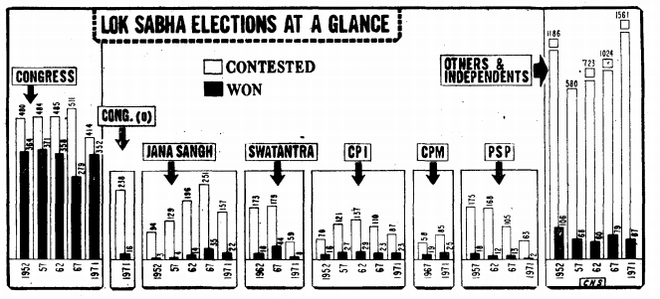
Now the Opposition was making a renewed attempt to cut through the Congress’ unbroken 30-year run since Independence.
Six parties, with wildly differing ideologies, were part of the coalition — Jan Sangh, Congress (O), Bharatiya Lok Dal, Socialist party of PSP and SSP, Swatantra Party and the newly formed Congress for Democracy — under the inspired leadership of Jaya Prakash Narayan. Mr. Narayan, a freedom fighter of the Congress old guard since 1929, left the party in 1948 along with other Congress Socialists. He formed the Praja Socialist Party in 1952. In 1974, Mr. Narayan emerged as a fierce critic of Mrs. Gandhi, and soon became a rallying point for Emergency-era opposition.
The Janata Party described its emergence as a response necessitated by the ruling party’s move towards assumption of absolute power. In its manifesto, it vowed to “defend the people’s democratic rights and livelihood.” This manifesto revealed the variegated nature of the cobbled-together alliance.
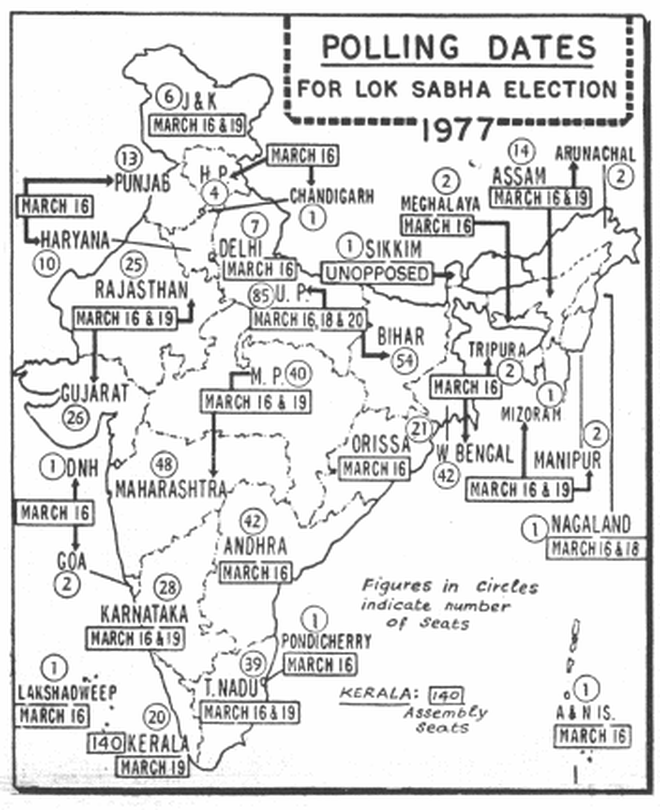
“It is an interesting study in give-and-take for the Jan Sangh to accept Gandhian Socialism, for Mr. Morarji Desai to endorse the concept of bonus as deferred wage, for Mr. Charan Singh to agree to exemption of small agricultural holdings from the incidence of land revenue and for the former Swatantra members to accept deletion of property as a fundamental right,” K.K. Katyal noted in an editorial for The Hindu.
On one issue though, all the Opposition parties and the CPM were united— total disapproval of the Emergency. The Congress defended itself, and its ally CPI offered support while disapproving of later developments during the Emergency.
Congress remained sceptical of the Opposition combine, saying that parties, “wedded to communalism, reaction or left extremism” had different, even conflicting ideologies, but united “only to oppose the progressive policies of the Congress.”
Election Day
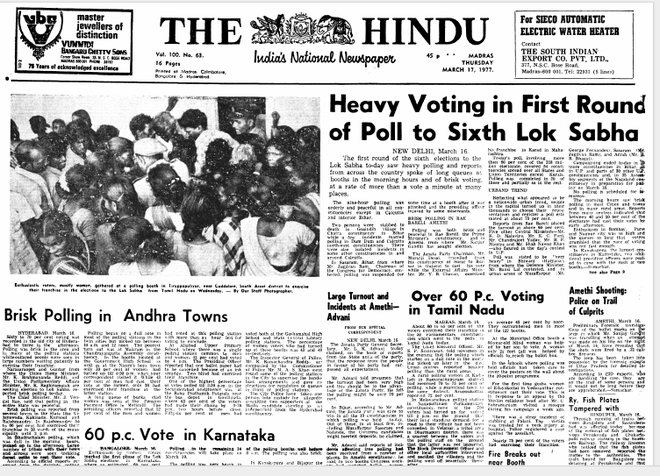
When poll day dawned, on March 16, 1977, people turned out in record numbers to vote. Per The Hindu reports from that year, States like Tamil Nadu and Karnataka saw over 60% voting on the first day itself. Sixty to 70% voting was reported from old Hyderabad as well. Polling in 300 of 540 constituencies was finished on the first day, with the final poll of the marathon voting exercise held on March 20, 1977.
The results
Janata wave in the north
As Arif Beg, a Janata Party candidate who defeated Congress veteran Dr. Shankhar Dayal Sharma put it, the 1977 election was “not an election, it is a revolution.”
In an astonishing reverse, the Congress went from 350 seats in the Lok Sabha to 153. Congress saw a near-total rout along the Hindi belt, with a Janata Party wave taking over Uttar Pradesh, Bihar, Haryana, Punjab and other northern regions. Congress did not win a single seat in several Hindi States.
Prime Minister Indira Gandhi lost to Raj Narain from her stronghold seat in Rae Bareli, a constituency she had held with big majorities. “The myth of her infallibility” has broken, “does this mean that the Nehru legend or legacy has come to an end through her stunning reverse in these elections?” editorials wrote of Mrs. Gandhi’s defeat. “Has she been swept away for good from the political scene?” Sanjay Gandhi, too, lost to Janata Party’s Ravindra Pratap Singh, from another Congress stronghold – Amethi.
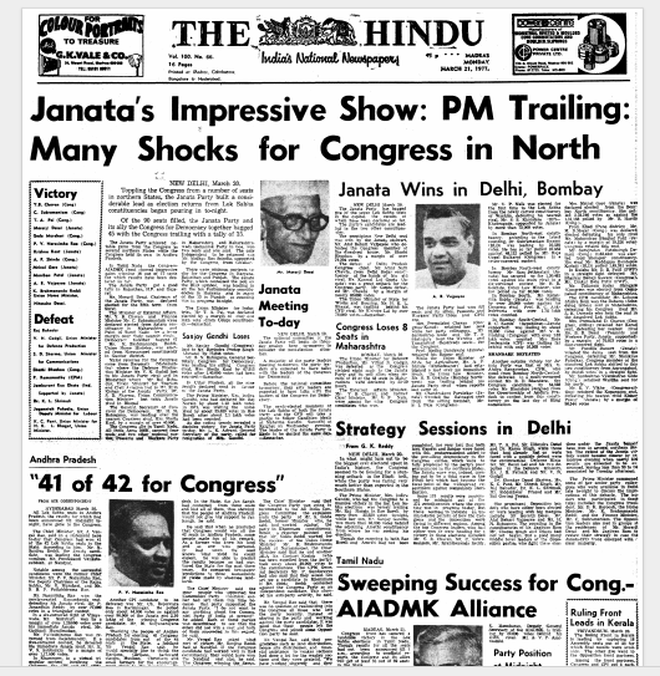
Two central themes permeated the North as reasons for the pro-Janata wave— the excesses of Emergency and the disastrous family planning measures that evoked public outrage. These excesses included the detention and alleged ill-treatment of detenues; which people believed despite official denial. Also common were reports of the police letting loose a reign of terror, extorting and demanding bribes of the public. Many leading citizens were incarcerated without trial; after their release following the dissolution of the fifth Lok Sabha, they elicited public sympathy, heralded as martyrs. The educated urban population was also irked by the curbing of civil liberties and press censorship.
Reports outlined that the “hurried and immature attempts in the northern States to make up for lost time by the use of indiscriminate strong-arm methods for mass compulsory sterilisation” evoked popular anger against Mrs. Gandhi — “whether or not she herself had had a hand in the misdeed.”
The sterilisation drive was zealous — often worryingly so. While the Centre set a 4 lakh target for sterilisation, the UP State government increased it to 15 lakhs and directed authorities to achieve this goal through any means necessary. There was reportedly use of coercion and force to conduct sterilisation on helpless young people even in ineligible categories, especially in Haryana and some parts of Himachal Pradesh.
All those closely associated with the Emergency were defeated — including Mrs.Gandhi and Union Information and Broadcasting Minister V.C Shukla. Senior Congress leaders such as Mr. Swaran Singh, former Minister of External Affairs and Chairman of the Constitution Amendment committee, K.D Malaviya, G.S Dhillon and B.R Bhagat lost.
Opposition leaders who were targets during the Emergency, such as George Fernandes, Jyotirmoy Bosu, Madu Limaye, and Karpuri Thakur, won. The only senior Opposition leader to lose was Biloo Mody.
Calling the Janata Party victory “a tremendous opportunity and challenge,” a Hindu editorial opined that “one does not know how the Opposition is going to cope”. The Congress MPs gathering in Delhi for the opening session were described as seemingly overtaken by a “benumbed feeling” — as if the Congress was suddenly overtaken by “a silent revolution.”
Certain other issues had an impact on Congress’ local electoral chances. In UP, farmers were put off by increased land revenue, power and irrigation tariffs, and were not placated by last minute measures like halving the land revenue. In Rajasthan, the lack of rehabilitation for released bonded labour and the abolition of traditional lending agencies sans replacement had an impact as well. Bihar’s caste-ridden bureaucracy oppressed the people, and police sought bribes under the guise of seeking land arrears. The youth were restless and threw their weight behind the Janata Party.
The Janata Party campaign saw support from many factions, including professors, lawyers and students. A report noted that students from medical colleges and IITs “who normally shun political work” went to Amethi to campaign against the Gandhis. The Janata Party funds came from people’s own pockets; students even collected funds by shoe-shining and small donations.
In UP, the Janata Party benefited from the fact that communal tensions were set aside temporarily— while Muslims voted for Jan Sangh candidates, RSS workers campaigned for Janata Party Muslim candidates. Additionally, the Shahi Imam of the Delhi Jama Masjid toured extensively and mobilised Muslim votes in the State for the Janata Party. Jai Gurudev followers also influenced rural areas and backward classes.
The Congress, which had depended on traditional Harijan and Muslim votes, found itself caught on the wrong foot. Jagjivan Ram’s exit from Congress split the Harijan vote to a certain extent. Even Mrs. Gandhi’s large tours in Uttar Pradesh did not carry Congress to victory; the Opposition held multiple large rallies in every constituency, while often Mrs. Gandhi’s addresses were the only Congress events held. The Congress lost across all 85 constituencies in the State from which Prime Ministers had hailed for three decades.
It also drew a complete blank in Bihar— then the second most populous State— and won only 3 seats in West Bengal. Nitish Chakravarthy wrote for the Hindu that there was “no easy explanation” for “the wholesale support given to the Janata-CFD candidates by voters in a State where leftism is more than a mere shibboleth and where youth is still fired by idealism.” — even though the combine had the Communist Party of India (Marxist)‘s backing.
States at a glance:
Congress still charms the South
In a conspicuous contrast, the southern States witnessed a Congress sweep, while the Janata-CFD Front fared miserably.
Press censorship during the Emergency ensured that the southern States were kept “ignorant of the gross excesses of the family planning drive in the Hindi-speaking States and other acts of repression,” an editorial noted. Additionally, southern States, especially Maharashtra, Kerala and Tamil Nadu achieved far better results in family planning and brought down the birth rate to below 30 per thousand, while it still remained around 35 per thousand in the Hindi-speaking belt. These results were obtained through a “judicious combination of motivation, monetary and other incentives, after-care of sterilisation acceptors in well-conducted F.P camps and some element of compulsion even”.
Further, while the theme of democracy versus dictatorship went down well in the urban areas, agricultural labourers in States like Andhra Pradesh were more concerned with day-to-day problems such as higher wages. In some cases, Congress and Janata candidates came from the same communities, splitting the vote. For example, in Andhra Pradesh, candidates hailed from the same Kamma community.
Finally, although the Janata Party gained traction in urban areas, urban women still voted in significant numbers for the Congress — out of respect for a woman Prime Minister.
Congress maintained a strong footing in Karnataka and Tamil Nadu— where it tied up with AIADMK, headed by MG Ramachandran. It won all seats in Kerala and 41 of 42 seats in Andhra Pradesh; of the latter a post election analysis concluded that, “Mrs. Indira Gandhi has been the best vote-getter for the Congress in the State and the poorer sections here appear to have responded to her call because of their faith in her policies designed to help them.”
States at a glance:
Other States see chequered results
In Odisha, the Janata wave did not permeate south of the Rushikulya river. All four constituencies between the river and the Andhra border returned Congress candidates— the only four seats it got out of Odisha’s 21 seats. Those defeated in Odisha included J.B Patnaik, Minister of State for Defence. The Janata wave coupled with poverty caused by two years of intensive drought (1973-1974), polarisation and the leadership of Biju Patnaik returned the Janata- CFD- CPM combine with 16 seats. This was one more than the Congress record of 15 seats in 1971. A notable cause of resentment was a showy reception accorded to Sanjay Gandhi, reportedly costing Rs. 6 lakhs, at a time when the State was reeling from drought and poverty.
Although Maharashtra was always considered a safe pocket of Congress, even by some Opposition leaders, the Janata Party made “appreciable dents” in many Congress strongholds. The Congress got 20 seats of 48 in the State, while the Janata-CFD combine got 19. The Peasants and Workers Party won five seats, and the CPM got three. The Republican Party (Khobragade) got one. The CPI was routed completely. The Opposition trounced the Congress in Bombay, the Congress’ birthplace which had always stood stolidly behind the party, even during the separate Maharashtra movement of 1957.
While outgoing Law Minister H.R Gokhale lost to Ram Jethamalani, Dr. Subramaniam Swamy defeated Raja Kulkarni, a member of the dissolved Lok Sabha. However, Congress stalwart Y.B Chavan was returned with the biggest winning margin in the State.
Post-election analysis cited apathy of mill workers, government employees, womenfolk and slum dwellers as reasons for the Congress reverse. College groups too actively worked for Janata candidates. A last minute appeal by Shiv Sena leader Bal Thackerey to vote for Mrs. Gandhi fell on deaf ears, as many party workers canvassed for Janata Party candidates.
Gujarat saw a mixed result, with the Janata front garnering 16 seats as compared to the Congress’ 10.
States at a glance:
The aftermath
As her party’s numbers whittled to a minority in the Lok Sabha, it was time for Indira Gandhi to step away from the Prime Minister’s mantle — albeit briefly.
An editorial said the sixth Lok Sabha was “advancing towards a virtually two party parliamentary system”— a development deemed a “most desirable thing in the evolution of our young democracy.”
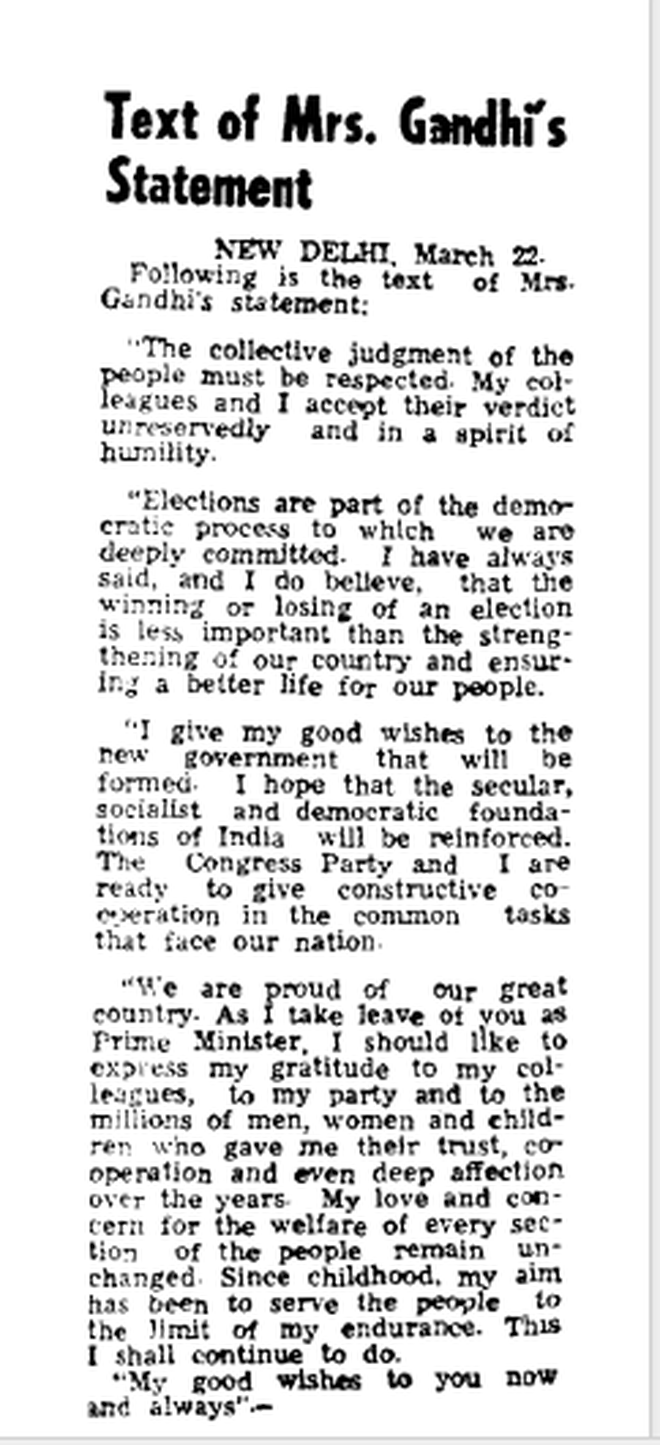
In a statement, Mrs. Gandhi expressed a wish that the “secular, socialist and democratic foundations of India will be reinforced.” Following this, she tendered her resignation to B.D Jatti, the acting President.
Soon after, M.M Jalisatgi, President of the Karnataka District Congress Committee said that Congress candidate B.P Kadam would be willing to resign, and that Mrs.Gandhi could consider contesting from Kanara. This was merely a foreshadowing of what was to come; while the Congress (I) swept the 1978 Assembly elections in Karnataka, Mrs. Gandhi won a Lok Sabha byelection in Chikmagalur— key moments in the return of the Congress to power.
For now, Mrs. Gandhi was succeeded by Morarji Desai, the Chairman of the Janata Party, as the next Prime Minister. This choice too was not free of controversy— many believed that Jagjivan Ram was better suited for the role. However, he was unanimously announced to “thunderous cheers” by Acharya J.B Kripalani, in the presence of Jaya Prakash Narayan in the Central Hall of the Parliament House on March 24. Recalling the lines from the Hindi poet Dinkar he had used to call upon Mrs. Gandhi to vacate her throne, Mr. Narayan cautioned the Prime Minister to not repeat the mistakes of his predecessor which led to this “silent revolution.”
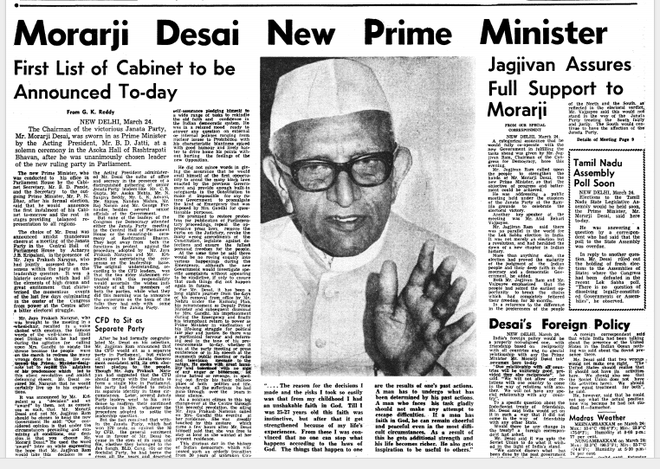
Meanwhile, the CFD, sore over the choice of leader, announced that it would sit as a separate party in the Parliament, while extending support to the Janata Party.
Road to next election
Although the Janata Party wave swept away the Congress government at the Centre and in many States, its patchwork alliance did not hold together for long.
Differences were sparked by Jagjivan Ram being snubbed for the Prime Ministerial post in favour of Morarji Desai, and Mr. Ram did not join the new government. The uneasy alliance split further as socialist-trade unionist members questioned the RSS links of erstwhile Jan Sangh members. Further, although the Shah Commission was launched to look into the excesses of the emergency, its reports did not bring any gains for the Janata Party.
In between, Charan Singh was sworn in as PM with Mrs. Gandhi’s support but he only remained in power briefly, and early elections were called in 1980.
During this time, since Assembly polls were delinked from Lok Sabha polls, the Janata Party government dismissed 10 State governments and made them go for a repoll, leading to instability.
And Indira Gandhi still held a sway over the public consciousness. In the 1980 elections, she made a triumphant comeback, pledging stability in the face of the wavering Janata Party regime. Congress (I), her faction of the Congress, secured two-thirds majority in the Parliament. In a reversal of its fortunes, the Janata Party failed to get even 50 seats. In a turning of the tide, the left and democratic front led by CPI(M) emerged as the largest Opposition party.
Indira Gandhi soon returned to power.
Note: Credit for The Hindu newspaper reports, clippings and editorials goes to the Hindu Archives. Election statistics have been obtained from the Election Commission of India website.



!["[T]he First and Fifth Amendments Require ICE to Provide Information About the Whereabouts of a Detained Person"](https://images.inkl.com/s3/publisher/cover/212/reason-cover.png?w=600)



